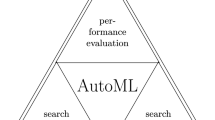Abstract
In this paper, we propose an extreme learning machine (ELM) with tunable activation function (TAF-ELM) learning algorithm, which determines its activation functions dynamically by means of the differential evolution algorithm based on the input data. The main objective is to overcome the problem dependence of fixed slop of the activation function in ELM. We mainly considered the issue of processing of benchmark problems on function approximation and pattern classification. Compared with ELM and E-ELM learning algorithms with the same network size or compact network configuration, the proposed algorithm has improved generalization performance with good accuracy. In addition, the proposed algorithm also has very good performance in the TAF neural networks learning algorithms.




Similar content being viewed by others
References
Huang GB, Zhu QY, Siew CK (2006) Extreme learning machine: theory and applications. Neurocomputing 70(1–3):489-501
Huang GB, Wang DH, Lan Y (2011) Extreme learning machines: a survey. Int J Mach Learn Cybern 2(2):107–122
Huang GB, Zhu QY, Siew CK (2004) Extreme learning machine: a new learning scheme of feedforward neural networks. In: Proceedings of the international joint conference on neural networks (IJCNN2004), Budapest, Hungary, pp 25–29
Li MB, Er MJ (2006) Nonlinear system identification using extreme learning machine. In: 9th International conference on control, automation, robotics and vision, pp 1–4
Li FC, Wang PK, Wang GE (2009) Comparison of the primitive classifiers with extreme learning machine in credit scoring. In: IEEE international conference on industrial engineering and engineering management, Hong Kong, pp 685–688
Li B, Li YB (2011) Chaotic time series prediction based on ELM learning algorithm. J Tianjing Unv 44(8):701–704
Han F, Huang DS (2006) Improved extreme learning machine for function approximation by encoding a priori information. Neurocomputing 69(16–18):2369–2373
Harpham C, Dawson CW (2006) The effect of different basis functions on a radial basis function network for time series prediction: a comparative study. Neurocomputing 69(16–18):2161–2170
Wu YS, Zhao MS (2001) A neuron model with trainable activation function (TAF) and its MFNN supervised learning. Sci China (Ser F) 44(5):366–375
Shen YJ, Wang BW (2004) A fast learning algorithm of neural network with tunable activation function. Sci China (Ser F) 47(1):126–136
Shen YJ, Wang BW, Chen FG, Cheng L (2004) A new multi-output nueral model with tunable activation function and its applications. Neural Process Lett 20:85–104
Zhu QY, Qin AK, Suganthan PN, Huang GB (2005) Evolutionary extreme learning machine. Pattern Recogn 38:1759–1763
Hornik K (1991) Approximation capabilities of multilayer feedforward networks. Neural Netw 4(2):251–257
Huang GB, Babri HA (1998) Upper bounds on the number of hidden neurons in feedforward networks with arbitrary bounded nonlinear activation functions. IEEE Trans Neural Netw 9(1):224–229
Huang GB (2003) Learning capability and storage capacity of two hidden layer feedforward networks. IEEE Trans Neural Netw 14(2):274–281
Li B, Li YB, Rong XW (2010) Intelligent optimization strategy for ELM-RBF neural networks. J Shandong Univ (Nat Sci) 45(5):48–52
Huang GB, Siew CK (2005) Extreme learning machine with randomly assigned RBF kernels. Int J Inf Technol 11(1):16–24
Murphy PM, Aha DW (2008) UCI repository of machine learning databases [online]. Availabe: http://archive.ics.uci.edu/ml/datasets.html
Redondo MF, Espinosa CH (1999) Generalization capability of one and two hidden layers. In: International joint conference on neural networks, Washington DC, vol 3, pp 1840–1843
Wei HK, Xu SX,Song WZ (2001) Generalization theory and generalizaiton methods for neural networks. Acta Automat Sin 27(6):806–815
Acknowledgments
This work was supported by the Independent Innovation Foundation of Shandong University Grant No. 2009JC010 and 2011JC011, the National Nature Science Foundation of China Grant No. 61075091, National Natural Science Foundation for Young Scholars of China (61105100) and the Natural Science Foundation of Shandong Province under grant No. Y2008G21 and Grant No. 2007BS01008.
Author information
Authors and Affiliations
Corresponding author
Rights and permissions
About this article
Cite this article
Li, B., Li, Y. & Rong, X. The extreme learning machine learning algorithm with tunable activation function. Neural Comput & Applic 22, 531–539 (2013). https://doi.org/10.1007/s00521-012-0858-9
Received:
Accepted:
Published:
Issue Date:
DOI: https://doi.org/10.1007/s00521-012-0858-9




